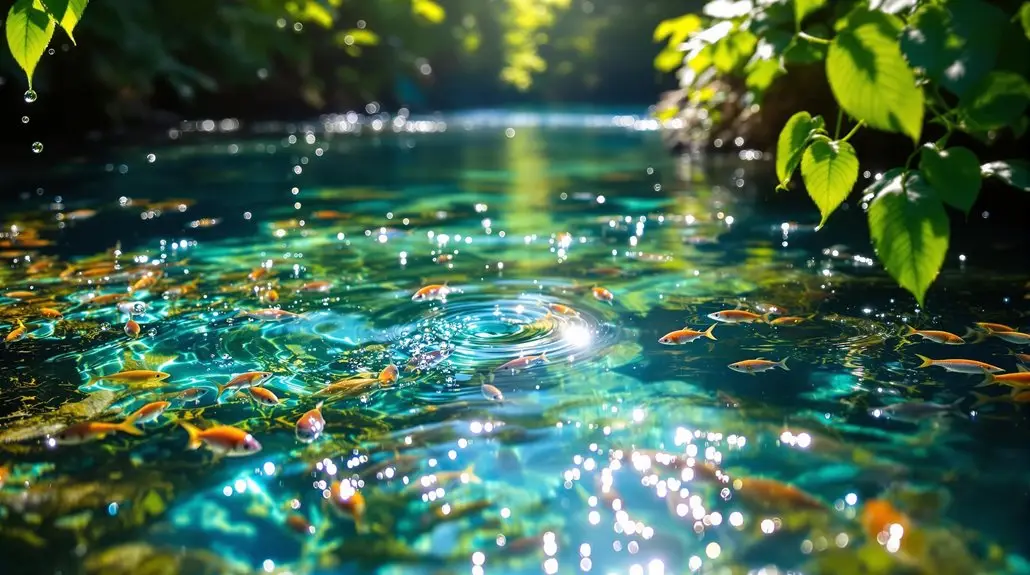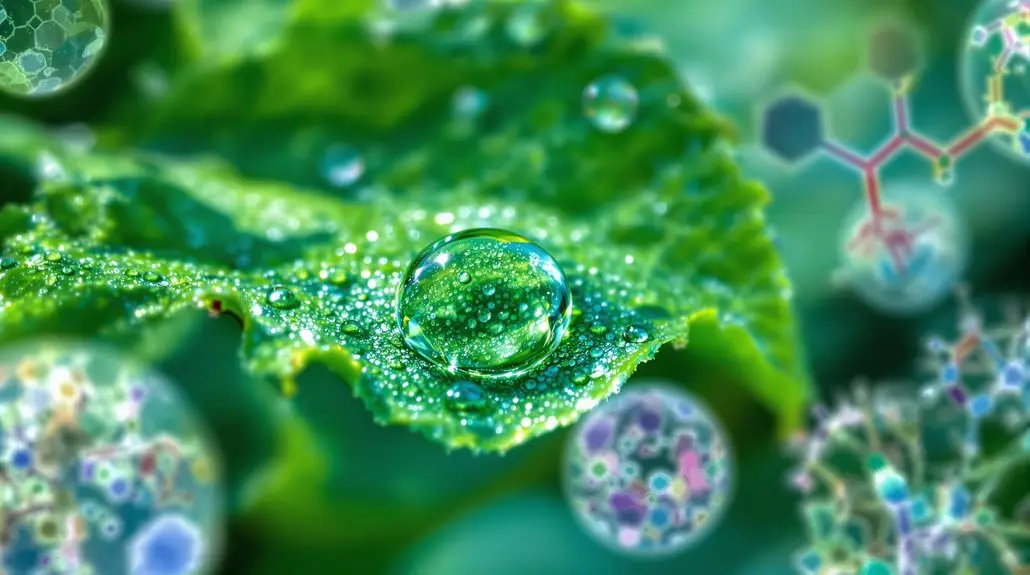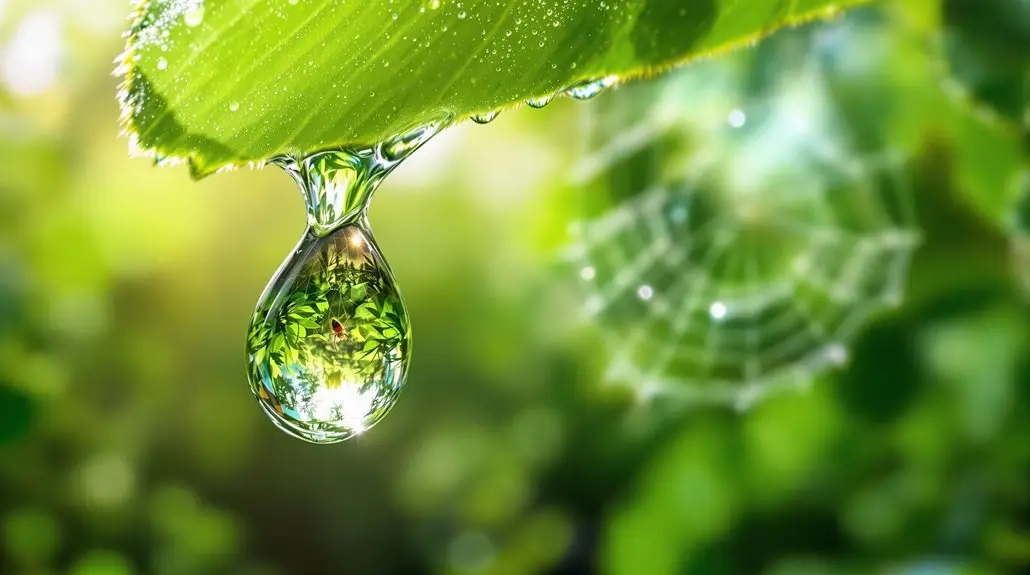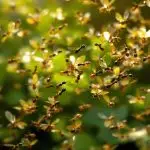Environmental fate studies of dinotefuran highlight its high water solubility and rapid breakdown in various conditions. Since it readily moves through aquatic environments, you should be aware of potential groundwater contamination. The half-life varies considerably; it degrades quickly in sunlight but can linger in dark conditions for up to 100 days. Additionally, while it poses low acute toxicity to mammals, it can disrupt local ecosystems, particularly affecting beneficial insects and soil organisms. Understanding these dynamics is essential for informed pesticide use, and there’s more to explore about its behavior and impact on the environment.
Key Insights
- Dinotefuran exhibits high water solubility, facilitating movement through aquatic environments and increasing leaching and runoff concerns.
- Rapid degradation occurs under light, with a half-life ranging from 0.9 to 8 days, while stability extends to 50-100 days in dark conditions.
- Aqueous photolysis leads to a half-life of approximately 1.8 days, indicating swift breakdown in natural sunlight.
- The accumulation potential in soil varies between enantiomers, with (+)-dinotefuran persisting longer than its counterpart, R-(-)-dinotefuran.
- Low aquatic toxicity and minimal bioaccumulation in species are noted due to rapid degradation, although negative effects on soil organisms are possible.
Overview of Dinotefuran

Dinotefuran, a neonicotinoid insecticide developed by Mitsui Chemicals, is recognized for its effectiveness in controlling a variety of pests. First registered in 2004, it has become a go-to solution in agriculture, veterinary care, and residential pest management.
You’ll find it particularly valuable for protecting crops like rice, vegetables, and fruits from common nuisances such as aphids, whiteflies, and leafhoppers. Its versatility makes it a staple in various regions, including Japan, the U.S., India, and Brazil. Additionally, it has gained popularity as a main insecticide for paddy fields, significantly enhancing crop protection.
When you look at its chemical properties, you’ll notice that dinotefuran appears as a white crystalline solid with a molecular formula of C7H14N4O3. It boasts low acute toxicity, classified as Category IV, meaning it’s generally secure for human health when used according to guidelines.
The mechanism of action targets nicotinic acetylcholine receptors specific to insects, which reduces risks for you and your loved ones.
You might also appreciate that dinotefuran is effective in managing resistance, making it a reliable choice over time. It’s used in flea and tick control for pets and provides effective termite solutions for homeowners.
Environmental Fate Mechanisms
When considering the environmental fate mechanisms of dinotefuran, it’s essential to understand how this compound behaves in different ecosystems. Dinotefuran’s high solubility in water—39.83 g/L—means it can easily move through aquatic environments. Its formulations, such as water-soluble granules and soluble concentrates, enhance this mobility.
In soil, dinotefuran shows a Kpc range of 6 – 45 mL g⁻¹, indicating it can also migrate quickly through soil layers. Once introduced into an ecosystem, dinotefuran undergoes rapid degradation, although the precise DT50 in water hasn’t been measured yet. Instead, photochemical oxidative pathways indicate a swift breakdown.
In animals, you’ll notice dinotefuran has a high oral absorption rate of over 90%, with major residues, including the parent compound and minor metabolites, primarily eliminated through urine within 24 hours. This low bioaccumulation potential suggests that while dinotefuran can be detected in the environment, it won’t persist long in living organisms.
Moreover, dinotefuran exhibits stereoselective behavior in water-sediment systems, with S-dinotefuran accumulating more in sediment and posing a potential risk to aquatic life, such as zebrafish. While R-dinotefuran seems to activate protective enzymes, the overall impact on ecosystems remains a concern. Additionally, the findings from multi-omics analyses reveal significant changes in gene and protein expression in zebrafish exposed to dinotefuran.
Given its high leachability and stability across a range of pH levels, understanding dinotefuran’s fate becomes vital for preserving our water resources and ensuring a healthy environment for all.
Half-life in Water

Understanding the half-life of dinotefuran in water is essential for determining its environmental impact. This compound behaves differently depending on whether light is present or not. In light conditions, dinotefuran breaks down relatively quickly, while it shows remarkable stability in the dark. Here’s a quick comparison to illustrate these differences:
| Condition | Half-life Range | Notes |
|---|---|---|
| Under Light | 0.9 to 8 days | Rapid degradation via photolysis |
| Without Light | 50 to 100 days | Minimal degradation due to hydrolysis |
| High pH (11-13) | 4.2 to 45 hours | Increased hydrolysis rates |
| Buffer solution pH 7 | ~0.9 days | Stable under neutral conditions |
In natural sunlight, dinotefuran’s half-life ranges from 2.3 to 2.4 days, while aqueous photolysis gives it a half-life of about 1.8 days. You might find it surprising that in dark conditions, the half-life extends dramatically, lasting up to 100 days. This stability indicates that dinotefuran can persist in water without light, making it essential to evaluate the conditions when determining its environmental impact. Additionally, its systemic nature necessitates caution in handling treated plants to prevent unintended exposure.
Factors like pH and light exposure greatly influence how long dinotefuran remains in water. Understanding these dynamics helps you appreciate its behavior in various environments, ensuring informed decisions about its use and management.
Soil Behavior and Persistence
The behavior of dinotefuran in soil considerably influences its environmental persistence and potential risks. With a high water solubility of 39.8 g/L, dinotefuran’s mobility in various soil types raises concerns about leaching and runoff. Its low sorption to organic matter means it doesn’t cling tightly to soil particles, which can lead to increased movement through soil layers and a higher chance of entering groundwater.
While it’s stable once absorbed by plants, its potential for accumulation in soil remains a significant consideration. Pesticide residues can be absorbed by plants and translocated to edible parts, highlighting the importance of monitoring residual levels.
Dinotefuran’s persistence varies between its enantiomers, with the (+)-dinotefuran lasting longer in soil than its counterpart. Factors like soil organic carbon content and pH play a role in its degradation, with higher organic matter often leading to faster breakdown. However, under certain conditions, like ligninolytic environments, dinotefuran may degrade more rapidly.
As you navigate the implications of using dinotefuran, it’s important to recognize its impact on soil health. Its presence can disrupt microbial communities and affect organisms like earthworms, which are essential for soil structure and fertility.
Plus, with its potential for bioaccumulation, non-target species can suffer from neurotoxic effects.
Understanding these dynamics is important for responsible use and management of dinotefuran. By being aware of its soil behavior and persistence, you can contribute to a healthier ecosystem and make informed choices in your gardening or agricultural practices.
Aquatic Behavior and Impact

Dinotefuran’s behavior in aquatic environments is vital for evaluating its environmental impact and protection. Understanding how this compound interacts with water bodies helps you gauge its reliability for aquatic life and ecosystems. Here are some key points to take into account:
- High Water Solubility: Dinotefuran dissolves easily in water, which can lead to its transport and leaching into aquatic ecosystems.
- Stability and Degradation: It remains stable in the absence of light for over 130 days but breaks down quickly in sunlight. Recent studies have shown that dinotefuran has a high-water solubility of 39,830 mg/L at 25 °C.
- Low Aquatic Toxicity: With high LD50 values, dinotefuran poses minimal risk to fish and Daphnia.
- Sediment Accumulation: Dinotefuran tends to accumulate in sediment, particularly in its S-form, which can affect local organisms.
While dinotefuran shows low bioaccumulation in aquatic species due to its rapid degradation, it’s important to note that its behavior can differ based on environmental conditions.
For instance, its half-life drops considerably when exposed to sunlight. Additionally, the compound affects different species in unique ways; while it’s less toxic to fish, it can cause oxidative damage in zebrafish with the S-dinotefuran form.
Chemical Properties of Dinotefuran
When you look at dinotefuran’s chemical properties, its solubility in water stands out at 39.83 g/L, indicating how it can interact with aquatic environments. Additionally, the melting point of 107.5°C reveals its stability under various conditions. Understanding these characteristics helps in evaluating its environmental behavior and potential impact. Moreover, dinotefuran’s high systemicity contributes to its effectiveness in targeting pests while minimizing harm to non-target organisms.
Solubility in Water
With a water solubility of 39.83 g/L, dinotefuran demonstrates a remarkable ability to dissolve in aquatic environments. This property greatly impacts its movement and behavior in nature, making it vital for anyone concerned about environmental security to understand.
- Dinotefuran’s solubility varies slightly with temperature, increasing from 39.0 g/L at 10 °C to 89.7 g/L at 30 °C.
- It shows different solubility levels across pH buffer solutions, peaking at 54.5 g/L at pH 7.0.
- High solubility facilitates leaching into lower soil layers, raising concerns about groundwater contamination.
- Consistent solubility data across various studies reinforces its reliability as a key environmental factor.
Recognizing dinotefuran’s solubility is essential for anyone involved in environmental protection or farming. Its ability to dissolve in water can lead to considerable implications for water quality and ecosystem health.
Melting Point Characteristics
Understanding the melting point characteristics of dinotefuran provides insight into its physical properties and stability under various conditions.
You’ll find that dinotefuran, with a molecular weight of 202.21, has a melting point range of 94.5–101.5°C for 99.5% purity and a slightly higher melting point of 107.5°C at 99.9% purity. This solid, white crystalline compound indicates that it remains stable and solid at moderate temperatures, which is essential for applications in various environments. The relative density of dinotefuran is 1.40 g/cm³ at 20°C, revealing that it’s denser than water, which affects its behavior in soil and water systems. Since it’s light-sensitive and has a relatively low vapor pressure, it doesn’t easily vaporize, further emphasizing its stability in solid form. Moreover, its high solubility in organic solvents enhances its application versatility in pest control formulations.
Metabolic Pathways in Organisms

When you look at the metabolic pathways of dinotefuran, you’ll notice that they can vary considerably across species. Major metabolites have been identified, showcasing how different organisms process this compound. Additionally, excretion patterns reveal key insights into how quickly dinotefuran is eliminated from various systems. Moreover, studies demonstrate that R-(-)-dinotefuran is more toxic than other enantiomers, which may influence its metabolic processing in different species.
Species-Specific Metabolism
Species-specific metabolism of dinotefuran reveals significant differences in how various organisms process this compound. For instance, the way rats metabolize dinotefuran contrasts sharply with goats and aquatic species like zebrafish.
Here are some key points to reflect upon:
- Rapid Absorption: Rats absorb dinotefuran quickly, with over 88% of the administered dose showing up in their system.
- Limited Metabolism: More than 90% of the dinotefuran dose remains unchanged in rats, with only minor metabolites formed.
- Unique Metabolites: Certain metabolites only appear in specific species, like lactating goats and laying hens.
- Enantioselective Effects: Different forms of dinotefuran exhibit varying toxic effects across species. Notably, enantioselective metabolic pathway changes were observed between R and S-dinotefuran in zebrafish.
These variations highlight the importance of understanding that different animals handle dinotefuran differently.
The metabolic pathways can affect how much of the compound remains in the environment and its potential risks to various species. Recognizing these differences not only helps in evaluating environmental impacts but also fosters a deeper appreciation for the complexity of nature’s interactions with chemicals like dinotefuran.
Major Metabolites Identified
Over time, researchers have identified several major metabolites of dinotefuran, each stemming from distinct metabolic pathways in various organisms. You’ll find that UF, or 1-methyl-3-(tetrahydro-3-furylmethyl) urea, is a prominent metabolite appearing in multiple tissues.
Another significant metabolite, FNG, or 2-nitro-1-(tetrahydro-3-furylmethyl) guanidine, pops up across various systems as well. DN, which is 1-methyl-3-(tetrahydro-3-furylmethyl) guanidium dihydrogen, is key in feces and other tissues, showing its importance in the overall metabolic profile. In studies involving rats and livestock, 446-DO, or 1-[4-hydroxy-2-(hydroxymethyl) butyl]-3-methyl-2-nitroguanidine, has also been identified as a major player. While MNG appears less frequently in discussions, it still holds relevance in the broader context of dinotefuran metabolism.
Recent studies have indicated that the toxicity of UF and DN is classified as supertoxic pollutants, highlighting their potential risks to the ecosystem. You can see that these metabolites are detected in various tissues, like the liver, where UF, FNG, and DN take center stage. Understanding these metabolites helps you appreciate the environmental implications of dinotefuran, as they affect both organisms and ecosystems.
Excretion Patterns Observed
Understanding the excretion patterns of dinotefuran reveals essential insights into its metabolic pathways across various organisms. You’ll find that the excretion dynamics vary, but some consistent themes emerge:
- Rapid Excretion: In rats, 84-99% of dinotefuran is eliminated in urine within 24 hours.
- Primary Elimination Route: Urine serves as the main pathway, accounting for 88-99.8% of excretion.
- Lactating Goats: The majority of dinotefuran remains unchanged and is found primarily in the liver.
- Laying Hens: Unchanged dinotefuran is the dominant residue in both egg white and yolk.
Across species, rapid absorption and subsequent excretion are apparent, indicating low bioaccumulation potential.
The elimination half-life ranges from 3.64 to 16.1 hours, depending on the specifics of administration.
Importantly, metabolic stability is high, with limited conversion and the primary metabolic routes being hydroxylation, oxidation, reduction, and acetylation.
This knowledge not only enhances your understanding of dinotefuran’s behavior in the environment but also supports the importance of responsible use and management of such compounds in agriculture.
Toxicological Profile
When evaluating the toxicological profile of dinotefuran, several key factors emerge that highlight its safety and risks.
First off, you’ll find that dinotefuran has low acute toxicity across various exposure routes, including oral, dermal, and inhalation. While it doesn’t irritate the skin of rabbits, it may cause slight irritation to the eyes. This is a significant point if you’re concerned about security.
Interestingly, dinotefuran exhibits neurotoxic effects on insects, but these aren’t a major concern for mammals after repeated exposure.
When it comes to cancer risk, studies show no carcinogenic potential in mice. Rats did show some neoplastic effects at high doses, but these are considered non-carcinogenic. You can also rest easy knowing it’s negative in mutagenicity studies.
While high doses can lead to decreased body weight across species, including dogs, the overall effects on reproductive health and immunity are reassuring. There’s no evidence suggesting reproductive toxicity or immunotoxicity, which is great for those of you focused on health impacts.
The toxicity endpoints reveal that the LD50 values are relatively high, indicating low toxicity. It’s remarkable that dinotefuran isn’t a skin sensitizer either. Moreover, the regulatory assessments support its safe use parameters, indicating that dinotefuran can be effectively used in various sectors.
However, keep in mind there are potential ecological risks tied to its metabolites and bioaccumulation in non-target organisms. By understanding these factors, you can better assess the implications of using dinotefuran in your environment.
Implications for Environmental Safety

Environmental safety is an essential factor in the use of dinotefuran, given its potential impacts on ecosystems. Understanding its behavior in water and soil helps you make informed decisions about its application and effects.
Here are a few key points to reflect on:
- Photodegradation: Dinotefuran breaks down quickly in water, with a half-life of just 1.8 days.
- Soil Mobility: Its low sorption coefficients mean it can easily leach and runoff, raising concerns about contamination of nearby water bodies. Effective pest control is achieved through safety-first approaches, which can help mitigate the risks associated with its use.
- Biodiversity Impact: This pesticide can negatively affect non-target organisms, particularly in agricultural settings, which might disrupt local ecosystems. For instance, studies indicate toxicity to beneficial insects such as pollinators and natural pest predators.
- Pesticide Resistance: Overusing dinotefuran could lead to resistance among target pests, complicating pest management.
These factors underline the importance of using dinotefuran responsibly. While it can be effective for pest control, its high mobility and potential for negative environmental impacts necessitate caution.
You’ll want to explore alternative strategies or integrated pest management practices to minimize risks. Continued research on dinotefuran’s ecological effects is vital for ensuring its secure use.
By staying informed and advocating for responsible practices, you can help protect the environment while still addressing pest challenges.
Choose Eco-Friendly Pest Control: Protect Your Home and the Planet with NaturePest!
In summary, understanding dinotefuran’s environmental fate is essential for evaluating its security. Did you know that its half-life in water can range from 1 to 10 days, depending on conditions? This variation highlights the importance of environmental factors in determining its persistence. By considering its behavior in soil and water, along with its metabolic pathways, you can better gauge the potential impacts on ecosystems and make informed decisions for environmental protection.
At NaturePest Holistic Pest Control, we believe in prioritizing eco-friendly solutions that safeguard both your home and the environment. Join us in making responsible choices when it comes to pest control. Learn more about our sustainable practices and how you can contribute to a healthier planet. Together, we can protect our ecosystems while effectively managing pests!



